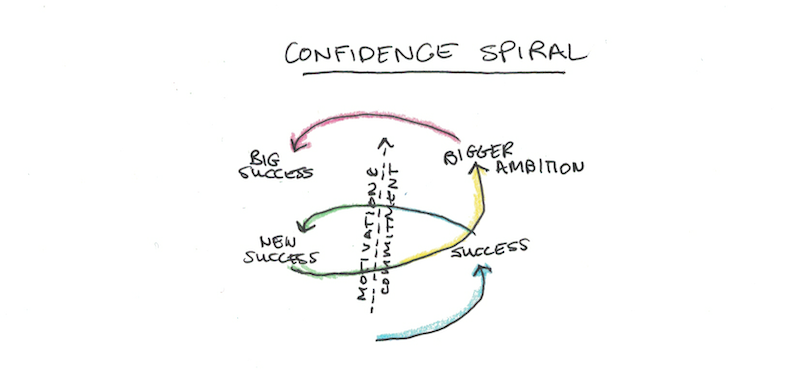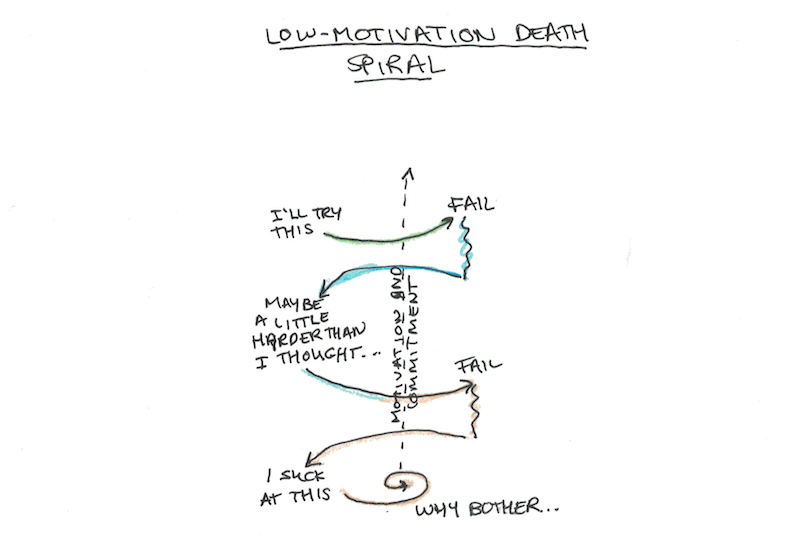Over the past week, I’ve been writing lessons in anticipation of a new session of my popular course, Make it Happen!
In case you missed those lessons, here are some links to get caught up:
Lesson 1: Why it’s so hard to stick to your goals (and how to make it easy)
Lesson 2: The simple algorithm for making big life decisions
Lesson 3: How to work on your goals when you don’t have time
Today I want to discuss a topic that is often a difficult one: how do I overcome my failures in the past? How do you take on those goals that you’ve tried many times before, and nothing ever seems to turn out?
Expectations and the Formula for Motivation
One academic theory of goal-setting is known as expectancy theory.
This theory states that your motivation for pursuing goals, whether they be big dreams like financial independence, or minor tasks like collecting the mail, depends on your expectations of success. The formula looks like this:
Motivation = [Value of Success] * [Probability of Being Successful] – [Effort]
If your goal is really valuable, chances of success are high and effort is low—it’s a no-brainer, you’ll definitely do it.
Things get more complicated, however, when we look at the second term in that formula. Probability of being successful itself can depend on motivation. Meaning, if you’re very motivated, committed and certain to stick to your goal, your probability of success might be much higher than if aren’t taking it very seriously.
This means motivation is both an input to the formula and the output. When something is an input and an output, you get feedback effects. Just like how if you put a microphone next to the speakers a small noise can get turned into a glaring screech, your own doubts can undermine your motivation.
The Confidence Spiral
This may sound academic, but it happens a lot more than you realize.
Consider Elon Musk. In 1995, he started his first company Zip2 and sold it for over $300 million, pocketing $22 million himself. Then he formed a company which merged with PayPal. When that sold, he went up to $165 million. Now he is taking on multiple leadership roles for Tesla, SpaceX and various other companies which have even more ambitious plans and business models.
Many people admire Musk, but if you look at his track-record, it’s easy to see why this ambition and confidence are natural. When your first company works out, earning you eight figures, and your second company works even better, earning you nine, why wouldn’t you think you can out-compete legacy car companies with a new electric car or build societies on Mars?

Musk’s motivation is also legendary, working 100+ hour weeks towards his dreams. While such extreme devotion may border on harmful obsession, it also follows from the math outlined above. When your perceived probability of success, enormous value of your mission and the confidence coming from having done similarly intensive things before get added up, the motivation is insane.
The Dangerous Spiral of Low Motivation
But just as feedback can enhance the motivation of many super-successful people, it can also do the opposite when the feedback you get is negative.
You try at a goal, but you fail. The next time you try, you feel less motivated, so you give up with a little less effort next time. Then you try again, but now you know you’re the kind of person who doesn’t stick to your goals, so you quit even earlier.

While few of us experience the uniformly positive feedback someone like Musk generated from his professional life, experiencing uniformly negative and dispiriting feedback is more common. This creates a spiral where you lose confidence, motivation and often the only option that feels possible is just trying to avoid that problem in your life.
How to Get Out of a Bad Confidence Spiral (and Enhance a Good One)
How do you get out of the negative spiral, if you feel like you might be in one?
The key is to start by taking small steps which you can almost certainly achieve. Breaking out of the spiral starts by making concrete steps forward, slowly rebuilding your faith in your own efforts. Done deliberately and patiently over time, this can turn a negative spiral into a positive one.
Throughout Make it Happen!, I’ll give you tools to analyze your own goals and break them down so that they become more achievable. We’ll do this by understanding our own psychology deeply and taking small, logical steps to improve how we do things. The goal isn’t to pump you up and inspire you, but to give you concrete methods to overcome your challenges.
Starting tomorrow, I’m going to be opening registration for Make it Happen! I hope to see you there with us.


 I'm a Wall Street Journal bestselling author, podcast host, computer programmer and an avid reader. Since 2006, I've published weekly essays on this website to help people like you learn and think better. My work has been featured in The New York Times, BBC, TEDx, Pocket, Business Insider and more. I don't promise I have all the answers, just a place to start.
I'm a Wall Street Journal bestselling author, podcast host, computer programmer and an avid reader. Since 2006, I've published weekly essays on this website to help people like you learn and think better. My work has been featured in The New York Times, BBC, TEDx, Pocket, Business Insider and more. I don't promise I have all the answers, just a place to start.